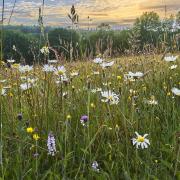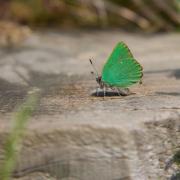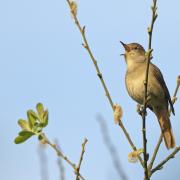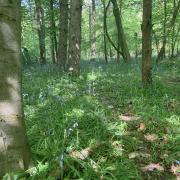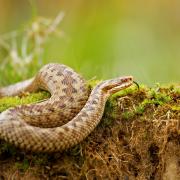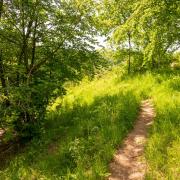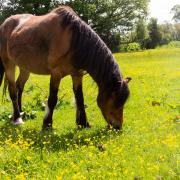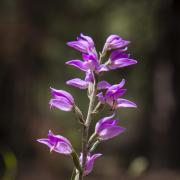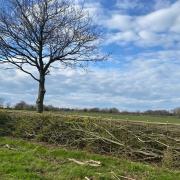The role of farmers in terms of conserving wildlife in Gloucestershire is becoming increasingly well recognised. Sue Bradley discovers how Gloucestershire Wildlife Trust is supporting them and meets a leader in this field
Looking after more than 40 nature reserves around the Cotswolds, Severn Vale and Forest of Dean is an important part of the work of the Gloucestershire Wildlife Trust, but the charity recognises that these sites are often small pieces of land that are part of a much larger picture.
That’s why it’s working closely with farmers to encourage their participation in a living landscape covering the entire county.
With the arrival of the Government’s Environmental Land Management Scheme (ELMS), which replaces the European Common Agricultural Policy with a system of rewards for public goods, its expertise is proving invaluable for helping landowners to make a positive impact.
In the years to come, farmers will receive payment for work undertaken that meets a series of objectives:
- Thriving plants and wildlife
- Clean and plentiful water
- Clean air
- Mitigation and adaption to climate change
- Reducing the risk of harm from environmental hazards, such as drought and flooding
- Enhanced beauty, heritage and engagement with the natural environment
Tim Bevan, the Trust’s Senior Wildlife and Farming Manager, says the charity can provide advice on the new ELMS scheme, including assistance with land management plans.

‘We have been carrying out projects with DEFRA called ‘tests and trials’ to fine tune the new scheme, a process known as ‘co-design’,’ Tim explains.
‘The first involved working with farmers across the county on land management plans showing how individual farms may already be delivering the six public goods and looking at ways to enhance them.
‘You would expect that Wildlife Trusts could support activity to deliver ‘thriving plants and wildlife’, such as manging diverse grasslands and pastures, managing hedgerows and woodlands and developing wetlands. Diversity on farms can also come from growing herb rich leys, reducing pesticide use and using longer and more complex cropping rotations.

‘We highlight if farms have land that is next to watercourses and suggest things farmers should be doing to protect these areas, such as growing permanent crops like grassland, trees and scrub.
‘When it comes to measures to alleviate flooding, we hope that under ELMS will be more encouraging to farmers to hold on to water in places that are suitable for this. Good soil health also has an important part to play alongside its role in promoting good harvests.’
Tim says it’s now widely recognised that isolated nature reserves aren’t enough to stop declining wildlife.
‘We need to join up the whole landscape, working with everybody and working at scale,’ he says.
‘This is a time of great change for farmers as direct payments are removed, a new support scheme is introduced and climate change imposes new challenges. There will be great demands put on the countryside to produce food, meet net zero targets and halt the decline in wildlife. It’s always a good time to plan and now is opportune to prepare for what is coming.’

Cotswold Great – Hedgerows
Hedgerows are a familiar sight within the Cotswold countryside and the unsung hero of farmland wildlife.
They’re important as a source of food for a variety of mammals, birds and insects, as well as for shelter and protection from predators.

Many hedgerows have been in place for scores if not hundreds of years, during which time a number of plant species will have come together, providing long periods of nectar and pollen for insects, which in turn join with berries and hips in feeding a variety of birds. Meanwhile, pieces of dead timber are a rich source of food for beetles.

Densely interwoven branches provide safe spots for birds and rodents to nest and take cover from birds of prey. Wrens, robins and dunnocks will usually raise their young closer to the ground while song thrushes, blackbirds, chaffinches and greenfinches prefer a position higher up.

Hedgerows represent long interconnected corridors for wildlife, often providing an essential link between small woodlands and enabling mammals and birds to find new sources of food and mates for breeding.
The RSPB estimates that hedgerows support up to 80% of woodland birds, 50% of mammals and 30% of butterflies, while the ditches and banks associated with them provide habitats for reptiles.

Hedgerow species
- Dog rose Rosa canina
- Blackthorn
- Hawthorn
- Yew
- Guelder-rose Viburnum opulus
- Oak
- Rowan
- Elder

Did you know?
Rosehips are rich in Vitamin C. During the Second World War, children were sent out to collect these hips so that they could be made into syrup. By 1943 some 500 tonnes were collected each year, equalling the nutritional value of 25 million oranges.

Eat the landscape
A few wildlife-friendly farmers producing food and drink in Gloucestershire:
- Simon Weaver Cheese, Upper Slaughter, simonweaverorganic.co.uk
- Jess’s Ladies organic dairy products, Hardwicke, theladiesorganickefir.co.uk
- Overbury Enterprises meat, overburyenterprises.co.uk
- Ruscombe Farm Red Poll beef, Ruscombe, ruscombefarm.co.uk
- Mark Tuffnell, Calmsden Farm, produces cereals for Jordans
- The National Trust sustainable meat boxes nationaltrust.org.uk/features/farm-fresh-meat-boxes

My Wild Life – Jake Freestone, farm manager at Overbury Enterprises
Conservation has always been at the heart of what we do at Overbury Enterprises, but the value of this work really hit home recently when I went out with a team of bird ringers and witnessed the variety of species found on the 4,000 acres we look after.
We hear and see a lot of skylarks overhead, but it was wonderful to see the goldfinches, yellowhammers and corn buntings up close.
We’ve been practising regenerative agriculture since 2013 and are convinced it’s the way ahead in terms of wildlife, the environment and food security, something that’s really come to the fore in recent months. It also makes good business sense, leading to reduced need for expensive inputs, and lowers our carbon footprint.
Our land, which includes part of Bredon Hill, has a real mix of soil types, including Cotswold brash and clay, and we have areas of woodland and lots of hedgerows.

The way we farm causes minimal soil disturbance and keeps living crops on the fields as much as we can. We have a slightly wider rotation – growing a succession of different species to avoid exhausting nutrients and reduce the risk of pests and diseases – which includes ‘cover crops’ to protect the soil. We also bring in a flock of sheep to clear patches of land and enrich it with their manure. These animals live healthy lives outdoors throughout the year, and with 45km of footpaths criss-crossing the estate, we’re grateful to dog owners who act responsibly and don’t allow their pets to run freely around livestock, which can lead to injury both to ewes and their lambs.
Taking care of our soil is important for many reasons, especially around Bredon Hill which historically has been susceptible to erosion. This substance is key to retaining moisture and nutrients.
Regenerative farming had led to us needing to buy in less manufactured fertiliser, while the beneficial insect life encouraged by wildflower margins means we’ve been able to stop using insecticides altogether. We’ve also dramatically cut down on fungicides over the last two seasons.
We’re proud of the work we’re doing here and were thrilled to be named the Farmers’ Weekly Environmental Champions 2021. Nevertheless, we’re always learning and fine-tuning what we do and are often consulting social media to catch up with the encouraging advances in regenerative farming around the world.
We’ve just signed up for another Higher Entry Level Stewardship scheme and look forward to many more years farming sympathetically with the wildlife we have here.




